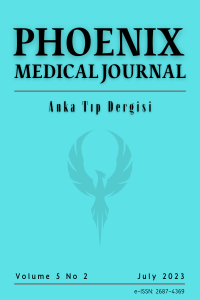Review
Research Article
Case Report
Image Presentation
Letter to Editor
Aim & Scope
Phoneix Medical Journal is a scientific journal that publishes retrospective, prospective or experimental research articles, review articles, case reports, editorial comment/discussion, letter to the editor, and aims to reach all national/international institutions and individuals.
Phoenix Medical Journal publishes actual studies in all fields of medicine. The journal is published three times a year and in March, July, and November. The official languages of the journal are Turkisha and English.
Phoenix Medical Journal respects the scientific submission of its authors, therefore, all submitted manuscript are processed through an expeditious double-blind peer review process. We aim at completing the review process within the scheduled time frame
This is an open-access journal which means that all content is freely available without charge to the user or his/her institution. Users are allowed to read, download, copy, distribute, print, search, or link to the full texts of the articles in this journal without asking prior permission from the publisher or the author.
Phoenix Medical Journal believes in safeguarding the privacy rights of human subjects. In order to comply with it, the journal instructs all authors (when uploading the manuscript) to also add the ethical clearance (human/animals) and informed consent of subject(s) included in the manuscript. This applies to Case Report/Reviews that involve animal/human subjects and specimens
Any processes and submissions about the journal can be made from the website: www.acilx.com
The author(s) undertake(s) all scientific responsibility for the manuscript.
Phoenix Medical Journal does not charge any article processing or submission fees to the authors.
Author Guidelines
AUTHORS GUIDELINES
Phoenix Medical Journal is a scientific journal that publishes retrospective, prospective or experimental research articles, review articles, case reports, editorial comment/discussion, letter to the editor, surgical technique, differential diagnosis, medical book reviews, questions-answers and also current issues of medical agenda from all fields of medicine and aims to reach all national/international institutions and individuals.
The journal is published three times in a year and in March, July, and November. The official languages of the journal are Turkish and English.
This is an open-access journal which means that all content is freely available without charge to the user or his/her institution. Users are allowed to read, download, copy, distribute, print, search, or link to the full texts of the articles in this journal without asking prior permission from the publisher or the author.
Any processes and submissions about the journal can be made from the website https://dergipark.org.tr/tr/pub/phnx. Past issues of the journal are also available at this website.
MANUSCRIPT PREPARATION
Authors are encouraged to follow the following principles before submitting their article:
- Research articles and article collections should not exceed 15 pages including the text, figures, tables, and references, while short announcements and case report presentations should not be longer than 5 pages, image presentations should not exceed 500 words.
- Author number for review articles should not exceed three.
- Author numbers for case report presentations should not exceed five.
- Author number for image presentations should not exceed three.
- The reference number for image presentations should not exceed five.
- Articles should be written with double space in 10 font size and right, left, upper and lower margins should all be 2,5 cm. writing style should be Arial.
- Manuscripts should have double-line spacing, leaving a sufficient margin on both sides.
- Manuscripts should be written with Microsoft Word.
- Abbreviations that are used should be defined in parenthesis where the full word is first mentioned.
Cover page (Title Page): The title of the article in Turkish and English, the names, surnames and titles of all authors, the name and city of the institution they work for should be included on this page. Internationally valid "ORCID" information of all authors should be included. If the article has been presented as a report at any meeting before, its place and date should be specified. The name, full address, telephone, fax, mobile phone and e-mail information of the correspondence author must also be added to this page.
ARTICLE SECTIONS
The text file should include the title in Turkish, keywords, the title in English, keywords in English, abstract, the text of the article, references, tables (only one table for one page) and figure legends (if any), respectively. Within the text file, the names of the authors, any information about the institutions, the figures and images should be excluded.
Abstract:
In original articles; Turkish and English abstracts should be written with the title of the article. The abstract should reflect the article, give important results and make a brief comment.
Abbreviations and references should not be used in the abstract. It should contain objective, material and method, results and conclusion sections and should not exceed 250 words.
In case reports; the abstract should be unstructured and shorter (average 100-150 words; without structural divisions in Turkish and English).
In reviews; the abstract should be written in both English and Turkish, and should not be configured. The abstract should not exceed 250 words.
Keywords:
- Keywords should be listed below the abstract.
- They should be minimally 2 and maximally 6, and should written English.
- The words should be separated by a semicolon (;), from each other.
- English keywords should be appropriate to “Medical Subject Headings (MESH)” (www.nlm.nih.gov/mesh/MBrowser.html).
- Turkish keywords should be appropriate to “Turkey Science Terms” (www.bilimterimleri.com).
Main text:
Main text in original articles; It should consist of Introduction, Materials and Methods, Results, Discussion and Conclusion sections.
In the introduction; the purpose of the article should be stated, the rationale of the study or observation should be summarized, only strictly appropriate references should be given, and the subject should not be reviewed extensively.
In the Materials and Methods section; the study design, selection and description of cases, technical methods, materials and procedures, and statistical methods used should be described.
Results section; Results should be presented in the text, tables and figures in logical order. In the text, all data in tables and / or figures should not be repeated, only important results should be highlighted or summarized.
In the discussion section; the new and important aspects of the study and their results should be emphasized. Detailed data given in the results sections should not be repeated. The conclusions and limitations of the study should be included in the discussion section. The results should be linked to other relevant studies.
Case reports should include introduction, case (s) presentation, discussion, and conclusion sections.
The main text in reviews should include title, abstract, keywords, text and references.
References:
When cited, the latest and most recent publications should be preferred. All sources must be shown in the main text by numbering them where appropriate. The authors are responsible for the correctness of the references. If possible, the DOI numbers of online articles that have been cited before must be provided. Journal titles should be abbreviated according to journal abbreviations at Index Medicus/Medline/PubMed.
The journal accepts an ANSI standard style adapted by the National Library of Medicine (NLM) as the writing style of the references. Authors can apply to http://www.nlm.nih.gov/bsd/uniform_requirements.html for examples of citing sources.
When there are six or fewer authors, all author names should be listed. If there are seven or more authors, then the first six authors should be put "et al." after writing. For writing in the text, Arabic numbers should be used in brackets when referring to sources in the main text for example (1,2).
Reference styles for different publication types are shown in the following examples:
Journal article
1. Ercan S, Yazkan R, Kolcu G, Başer Kolcu M, Gülle K, Koşar A. Süleyman Demirel Üniversitesi Tıp Fakültesi Dergisi’nin Son 10 Yılının Bibliyometrik Analizi. SDÜ Tıp Fakültesi Dergisi. 2019;26(2):123-129.
2. Akdeniz YS, Cakmak F, Ipekci A, Ikizceli I, Karatas KF, Berberoglu DB, et al. Videoscopic assisted retroperitoneal debridement in infected necrotizing pancreatitis. Phnx Med J. 2020;9(2):156-159. DOI: 10.1080/13651820701225688.
Book section
Ipekci A, Cakmak F, Akdeniz YS. Cell death: the significance of apoptosis. In: Ikizceli I, eds. International review of cytology. Istanbul: BTM; 2019. pp. 251–306.
Single authored book
Akdeniz YS. Health economics: fundamentals of funds. Istanbul: Kara Tren Yayınevi; 2019.
Editor(s) as author
Cakmak F, Ipekci A, editors. Mental health care for elderly people. Istanbul: Fatih Yayınevi; 2019.
Written at the meeting
Berberoglu D, Kocman AY, Cakmak K, Kanbakan A. Cannabinoids and pain. In: Ikızceli I, editor. Proceedings of the 10th World Congress on Emergency; 2020Aug 17-22; Istanbul, IASP Press;2020. p. 437-68.
Thesis
Memoglu F. Acil Servise Başvuran 65 Yaş Üzeri Travma Hastalarının İncelenmesi. Cerrahpaşa Tıp Fakültesi: İstanbul Üniersitesi; 2019.
Text published in electronic format
U.S. Department of Health and Human Services: The Health Consequences of Involuntary Exposure to Tobacco Smoke: A Report of the Surgeon General. Atlanta: U.S. Department of Health and Human Services, Centers for Disease Control and Prevention, National Center for Chronic Disease Prevention and Health Promotion, Office on Smoking and Health, 2006.
http://www.cdc.gov/tobacco/data_statistics/sgr/2006/pdfs/what-is-shs.pdf. Accessed 30 Nov 2014.
Tables, Figures, Pictures, and Graphics:
- All tables, figures, pictures, and graphics should be cited at the end of the relevant sentence.
- Each table, figure, picture and graphics should have a descriptive title. Arabic numbers should be preferred for tables, figures, pictures and graphics.
- Tables should be in the file where the article was submitted, should come after the references page, and each table should be written on a separate page. Tables should be numbered according to the order of appearance in the text. Heading of the table should be placed above the table. The descriptions and abbreviations should be placed under the table. Each table should be mentioned in the text.
- Each of the figures, pictures and graphics must be uploaded as a separate image file (jpeg, tiff, png or gif) with a minimum of 300 DPI.
- Heading of figures, pictures and graphics should be added to the end of the article.
- The manuscripts containing color figures/pictures/tables would be published if accepted by the Journal. In the case of publishing colorful artwork, the authors will be asked to pay extra printing costs.
- All abbreviations used, must be listed in the explanation which will be placed at the bottom of each table, figure, Picture and graphic.
- For tables, figures, pictures, and graphics to be reproduced relevant permissions need to be provided. This permission must be mentioned in the explanation.
- Pictures/photographs must be in color, clear and with appropriate contrast to separate details.
Conflict of interest: If any of the writers have a relationship based on self-interest, this should be explained.
Acknowledgment: Only acknowledge persons and institutions who have made substantial contributions to the study, but was not a writer of the paper.
Ethical approval: Studies must comply with the Declaration of Helsinki (https://www.wma.net/what-we-do/medical-ethics/declaration-of-helsinki/). Authors should indicate the date and number of ethics committee approval they received for their work requiring ethics committee approval, and from which institution it was obtained in the materials and methods section.
Copyright transfer form: By the Copyright Act of 1976, the publisher owns the copyright of all published articles. All manuscripts submitted must be accompanied by the “Copyright Transfer Form” that is available in www.acilx.com
Submission of manuscripts: Phoenix Medicel Journal only accepts manuscripts submitted online from the website at https://dergipark.org.tr/tr/pub/phnx. All articles must be sent from the system accessed by clicking the "Submit Article" icon at the relevant address.
Checklist for Submitted Articles:
Articles must be complete. They must include the following:
- Title Page
- Article sections
- Turkish and English titles
- Abstract (250 words) (Turkish and English)
- Keywords (minimum 3; maximum 6)
- Article divided into appropriate sections
- Complete and accurate references and citations
- List of references styled according to “journal requirements”
- All figures (with legends) and tables (with titles) cited.
- "Copyright Form" signed by all authors.
The evaluation process will not be initiated for manuscripts that do not meet the above conditions.
Ethical Principles and Publication Policy
The author(s) undertake(s) all scientific responsibility for the manuscript. All the authors must actively participate in the study. The author(s) guarantee(s) that neither the manuscript itself nor any substantially similar content thereof has been published considered for publication elsewhere. or is being. If the manuscript had been presented in a meeting before; the name, date, and province of the meeting should be noted.
The ICMJE suggests that the authors meet the following four criteria:
- To contribute to the content of the work/design and collection, analysis and interpretation of data for study;
- To have drafted the writing essay or have made critical reviews with an important intellectual content;
- To have reviewed and approved the last version of the article before its publication;
- To accept the responsibility for all aspects of working to ensure that questions concerning the validity and validity of any part of the work are properly investigated and resolved.
The protocol of the clinical investigations must be approved by the appropriate ethics committee of the related institution. All manuscripts dealing with human subjects must contain, in the Materials and Methods section, a statement indicating that the study has been approved by the committee or there should be a statement that the research was performed following the Declaration of Helsinki principles (https://www.wma.net/policy/). In research work which includes humans, informed consent must be obtained before the study and this should be stated in the text.
All papers reporting experiments using animals must include a statement in the Material and Methods section giving assurance that all animals have received humane care in compliance with the Guide for the Care and Use of Laboratory Animals (www.nap.edu/catalog/5140.html) and indicating approval by the institutional ethical review board.
Review Process: Upon submission, all manuscripts are reviewed to check for requirements requested by the Journal. Manuscripts that do not comply with these requirements will be sent back to authors without further evaluations. All the papers are first evaluated by the editor; later the papers are sent to advisory board members. If needed, some questions can be asked to the authors to answer; or some defaults may have to be corrected by the authors. The result can be acceptance, minor revision, major revision or rejection. Accepted manuscripts are forwarded for publication; in this stage, all information and data are checked and controlled properly; the proof of the article to be published by the journal are forwarded to the writers for proofreading and corrections.
This journal uses double-blind peer review, which means that both the reviewer and author identities are concealed from the reviewers, and vice versa, throughout the review process. To facilitate this, authors need to ensure that their manuscripts are prepared in a way that does not give away their identity.
Copyright Statement: By the Copyright Act of 1976, the publisher owns the copyright of all published articles. All manuscripts submitted must be accompanied by the “Copyright Transfer Form” that is available in www.acilx.com
Phoenix Medical Journal is an Open Access journal authors are entitled to make their article publicly available according to the terms of the CC BY 4.0 licence.
Authors who have published under a CC BY 4.0 licence may share and distribute their article on non-commercial websites and repositories.
Price Policy
Our journal has adopted the Open Access Policy, and no fees will be charged from the authors at any stage of the publication for the articles submitted.
Indexes
Journal Boards
Editor-in-Chief

Öğrenim Bilgisi
1975 – 1980 İlkokul Züferbey İlkokulu
1980 – 1986 Orta/Lise Mustafakemalpaşa Lisesi
1987 – 1993 Lisans Selçuk Üniversitesi Meram Tıp Fakültesi
1996 – 2000 Tıpta Uzmanlık Erciyes Üniversitesi Tıp Fakültesi Acil Tıp Anabilim Dalı
Akademik Görevler
1996 – 2000 Araştırma Görevlisi Erciyes Üniversitesi Tıp Fakültesi Acil Tıp Anabilim Dalı
2000 – 2002 Öğretim Görevlisi Erciyes Üniversitesi Tıp Fakültesi Acil Tıp Anabilim Dalı
2002 – 2006 Yardımcı Doçent Erciyes Üniversitesi Tıp Fakültesi Acil Tıp Anabilim Dalı
2006 – 2010 Doçent Erciyes Üniversitesi Tıp Fakültesi Acil Tıp Anabilim Dalı
2010 – 2013 Doçent İstanbul Üniversitesi Cerrahpaşa Tıp Fakültesi Acil Tıp Anabilim Dalı
2013 – Halen Profesör İstanbul Üniversitesi Cerrahpaşa Tıp Fakültesi Acil Tıp Anabilim Dalı
İdari Görevler
1993-1996 Bucak Devlet Hastanesi Acil Servis, Burdur, Acil Serviste Pratisyen Hekim
2008 – 2010 Erciyes Üniversitesi Tıp Fakültesi Acil Tıp Anabilim Dalı Başkanı
2016 – 2017 İstanbul Üniversitesi Cerrahpaşa Tıp Fakültesi Başhekim
2013 – 2016 İstanbul Üniversitesi Cerrahpaşa Tıp Fakültesi Başhekim Yardımcısı
2010 – Halen İstanbul Üniversitesi Cerrahpaşa Tıp Fakültesi Acil Tıp Anabilim Dalı Başkanı
Editors




Field Editors

Publishing Board
Secretary
English Language Advisor
A physician-scientist with specialized training in Child and Adolescent Psychiatry and Addiction Psychiatry. He completed his psychiatry residency and fellowship at Westchester Medical Center at New York Medical College, followed by a specialized fellowship in Addiction Psychiatry at UCLA.
Turkish Language Advisor
Statistic Advisor


Editorial Advisory Board
Breast Radiology, Interventional Radiology

Assoc.Prof. Akif Erbin completed his medical education at Istanbul University Istanbul Faculty of Medicine in 2006. In 2013, he completed his urology training at the Health Sciences University Training and Research Hospital and obtained the title of urology specialist. In 2020, he received the title of associate professor. Between 2020 and 2024, he worked at Haseki Training and Research Hospital. Currently, Dr. Akif Erbin has been working as a faculty member at Cam and Sakura City Hospital. He has a total of 64 international publications, mostly on uro-oncology and endourology. Dr. Akif Ebin holds the position of editor-in-chief at the Haseki medical journal and serves as a referee for over 50 publications, with a focus on those indexed in the SCIE.
A research associate having M.Sc. degree in medical ethics and history of medicine at the Cerrahpasa Faculty of Medicine, Graduate School of Health Sciences, Istanbul University. Having Ph.D. degree in medical ethics and history of medicine at the Cerrahpasa Faculty of Medicine, Institute of Graduate Studies, Istanbul University-Cerrahpasa.
Having experience of research in bioethics, clinical ethics, medical law-health policies, medical ethics education, history of medicine, ethics and philosophy of biomedical technologies in healthcare and the future of medicine. Having research, analysis and writing skills to develop a new idea, theory, system and/or model in bioethics, especially clinical ethics and ethics of the future of medicine by interdisciplinary or multidisciplinary studies. Having skills of academic research conducted by the qualitative research methods such as in-depth interview, focus group, case study research, record keeping and observation. In sense of analysis, conceptual analysis, descriptive content analysis, phenomenological analysis, hermeneutic analysis, and grounded theory as well as systematic review, meta-analysis and meta-synthesis depending on the relevant literature, law, policies and guides.
Having experience in medical ethics education, ethical case deliberation depending on ethical decision-making, and informed consent practices depending on role-playing for the second- and third-year medical school students. In addition to that having experience in privacy and ethical-effective communication techniques training organized by the Quality Management Directorate, Cerrahpasa Faculty of Medicine Hospital Management-Chief Physician, for healthcare professions working at the Cerrahpasa Faculty of Medicine Hospital such as residents (physician associates), supervisors, nurses, pharmacists, laboratory technicians, medical secretaries, admissions clerks, security staffs and caregivers. Education and training contents are planned and conducted in two parts as theoretical-interactive part and practice part. The first part comprises of combination of the direct instruction, the Socratic method and discussion method of teaching. The second part consists of the role-playing and demonstration method of teaching.
Having translation (English to Turkish & Turkish to English), editing, proofreading, reporting and reviewing skills in Turkish and English.
Areas of Expertise:, Bioethics, clinical ethics, clinical ethics consultation, medical law-health policies, research ethics, biomedical technologies (especially robotics, artificial intelligence and big data), ethics and philosophy of the future medicine (particularly roboethics, futurism and transhumanism), medical ethics education, history of medicine
Dr. Hazim Abdul Rahman Alhiti
General Surgeon Specialist M.D
Al-Ramadi Teaching Hospital
Chief of Breast Clinic (Hit General Hospital)
Chief of Cancer Clinic (Hit General Hospital)
Academic lecturer in al Mansour University college-Baghdad
Academic lecturer in the College of medicine-university of Fallujah
Academic lecturer in a college of medicine-Al Iraqi University
Academic lecturer (Electronic learning)- Tikrit University
Academic external examiner-college of Medicine- University of Baghdad
Academic external examiner-college of medicine- University of Ibn Sina
Academic external examiner- College of medicine-University of Al-Qadisiyah
Academic lecturer at the Higher Institute of Health, Al Anbar Directorate of Health
Head of the department in The Middle East University college-Baghdad
Head of Emergency Department, Higher Institute of Health, Al Anbar Directorate of Health
Author, Reviewer and editor



Phoenix Medical Journal is licensed under a Creative Commons Attribution 4.0 International License.

Phoenix Medical Journal has signed the Budapest Open Access Declaration.















